This site uses only a few technical cookies necessary for its operation. By continuing to browse, you accept their use.
To find out more...
To find out more...
The proper use of a pastry bag
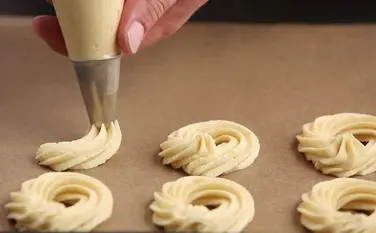
Ever used a pastry bag? Handy, isn't it, but unfortunately not very easy to fill. In fact, to be comfortable with this tool, you'd need 3 or 4 arms, which isn't very common.
Does that mean it's a goner? No, of course not. Here are 2 or 3 tips to help you get comfortable with it.
Does that mean it's a goner? No, of course not. Here are 2 or 3 tips to help you get comfortable with it.
8,852 4.7/5 (19 reviews)
Keywords for this post:PastryPastry bagPastry tipUtensilMethodLast modified on: December 5th 2020
The proper use of a pastry bag
What is a pastry bag?

Quite simply, it's a kind of large cone-shaped plastic bag (the pouch), in the bottom of which we place an outlet, usually made of very hard plastic, polycarbonate (the socket).
The bag is filled with the chosen preparation - cream, paste, mousse, etc. - then closed, and the contents squeezed out through the nozzle.
This gives you complete control over the output (flow) and shape of the cream/paste, thanks to the nozzle.
It's the favorite, indispensable tool of pastry chefs, who use it time and time again. In fact, they use the term "pocher", which in this context doesn't mean cooking, but dressing with a pastry bag.
In fact, bakers love to gently mock pastry chefs by saying that they "can't do anything without a pastry bag".
Useful at home?
Oh yes, indispensable even for an incredible number of preparations of all kinds. It's virtually impossible, for example, to make anything aesthetically pleasing in choux pastry without "poaching".
Difficult?
It's hardly complicated in principle, you just press on the bag and the mixture comes out, after which it's much harder to control the effort and precision of the gesture, but that comes with time.
Poaching regular macaroons, for example, is not at all easy, especially at first.
The first difficulty is filling the pouch, which sounds a bit odd when you say it like that, but if you're alone in the kitchen, it can quickly become a real pain: you have to spread the pouch, pour in the cream (sometimes in several stages), push it to the bottom, scrape out the rest, be careful that what's in the pouch starts to come out through the nozzle when the filling isn't finished, close the pouch, avoid air bubbles and leaks, and that's where the 3 or 4 arms I mentioned almost come into their own...
How do you do it?
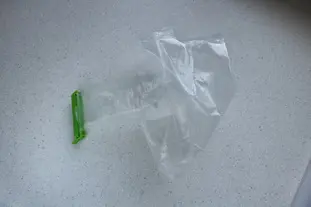 1) If your preparation is rather liquid, such as mousse, cream, etc., pinch the tip of the bag with a frozen food clip, a large clothespin or even a rubber band to prevent leakage during filling.
1) If your preparation is rather liquid, such as mousse, cream, etc., pinch the tip of the bag with a frozen food clip, a large clothespin or even a rubber band to prevent leakage during filling.
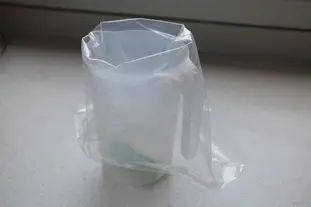 2) Place the empty, pinched pouch in a container with a high rim (like a graduated liter), spread the edges apart and place in front of you.
2) Place the empty, pinched pouch in a container with a high rim (like a graduated liter), spread the edges apart and place in front of you.
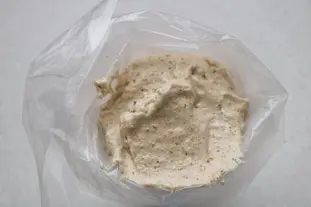 3) Slowly pour the mixture into the bag, then scrape it all down with a maryse (no spillage).
3) Slowly pour the mixture into the bag, then scrape it all down with a maryse (no spillage).
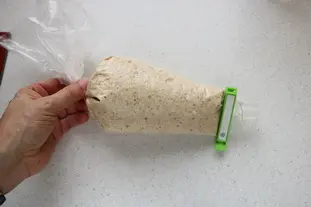 4) Close the pouch by twisting the plastic (to avoid air bubbles) and remove it from the high-sided container. You can leave it to stand for a while, so your preparation is protected from the air.
4) Close the pouch by twisting the plastic (to avoid air bubbles) and remove it from the high-sided container. You can leave it to stand for a while, so your preparation is protected from the air.
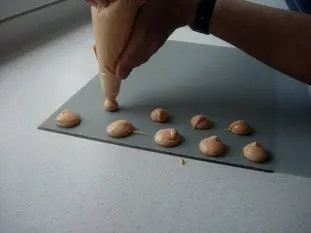 5) When you're ready to poach, place the pouch with the tip upwards, remove the tongs, turn downwards and poach!
5) When you're ready to poach, place the pouch with the tip upwards, remove the tongs, turn downwards and poach!
That's it, you know it all, but I'd like to finish by pointing out that, at first, it can be a bit disastrous, as you have very little control over the flow of the pouch and the shaping, but don't lose hope, you'll see with time and experience, it'll come...
Tosum up: to fill a pouch properly, pinch the end if the preparation is rather liquid, then fill with the pouch placed in a high-sided container, not held in the hand.
Lasts posts
Butter vs. grease
We often read in a recipe where a pastry is put into a mould that, just before pouring, the mould should be buttered or greased. But what's the difference between these 2 terms?December 1st 20258295
Getting out of the fridge early
Very often when you're cooking, you need to take food or preparations out of the fridge, to use them in the recipe in progress. There's nothing tricky about this: you just take them out of the fridge and use them, usually immediately, in the recipe. But is this really a good method?November 24th 20251,0265
Who's making the croissants?
When you look at a bakery from the outside, you naturally think that in the bakery, the bakers make the bread, and in the laboratory, the pastry chefs make the cakes. It's very often like that, with each of these professions having quite different ways of working, but sometimes there's also one...November 23th 2025926
Oven height
When we put a dish or cake in the oven, we naturally tend to put it on the middle shelf, and that's what we usually do. But in some cases, this position and height can be a little tricky, so let's find out why.October 8th 20252,5605
The importance of sieving
In recipes that use a fine powder (flour, powdered sugar, etc.), you'll often see the advice to sift before using it. To sift is to pass the powder in question through a sieve (a very fine strainer) before incorporating it into your recipe. It's often advice, but is it really useful?September 3rd 20257,4183
Other pages you may also like
Cooking cauliflower
Dramatic observation: cauliflower when cooked has a bad reputation ("it doesn't smell good!" and the like), and yet it's an excellent vegetable, very Breton, that deserves to be treated well, to give the best of itself.August 29th 202312 K3.3
The power of sayings and beliefs in the kitchen
One day, in the comments on the recipe for beaten egg whites, a young woman asked if you could beat egg whites stiff while having a period, as a friend had told her it wasn't possible. Sometime later another person commented that for mayonnaise it had been (get this!) scientifically proven that a...February 6th 201152 K4.4
Choosing a chopping board
It's a no-brainer, surely? If you want a chopping board, just find a piece of wood, and Bob's your uncle! You can happily chop away with a knife and not damage the table or worktop. But in reality, it's a bit more complicated than that. You need to be careful what you are buying, in particular the...May 8th 201250 K4.6
Should a sausage be pricked before cooking?
If you are using sausages in a recipe, you may have already asked yourself the question: Should you prick it before cooking it, or not? You will certainly find as many opinions "you should prick" as "you should not". Let's try to untangle all this.September 29th 201848 K4.1
The beautiful story of the croissants
As you may have already noticed, cooking, baking and pastry-making are full of stories or legends, usually very romantic, about this or that product or recipe. This is often the case for named recipes, for example tarte tatin, peach melba, paris-brest and many others, but it also applies to very...October 10th 201819 K5
Post a comment or question
Follow this page
If you are interested in this page, you can "follow" it, by entering your email address here. You will then receive a notification immediately each time the page is modified or a new comment is added. Please note that you will need to confirm this following.
Note: We'll never share your e-mail address with anyone else.
Alternatively: you can subscribe to the mailing list of cooling-ez.com , you will receive a e-mail for each new recipe published on the site.









